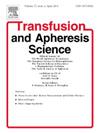Haemolysis in red blood cell components is associated with donor ferritin and body mass index status, but not donation frequency
IF 1.4
4区 医学
Q4 HEMATOLOGY
引用次数: 0
Abstract
Whole blood donors who donate more frequency are more likely to develop iron deficiency, which could potentially affect the quality of the red blood cell (RBC) components during storage. Additional donor factors such as sex, age at donation, donor body mass index (BMI), as well as the manufacturing method could also affect RBC component quality, particularly haemolysis. The aim of this study was to examine the relationship between donation frequency, donor ferritin levels and BMI status on an extensive set of RBC characteristics in vitro, during storage at 2–6 °C for 42 days. A whole blood donation was collected from 787 Australian blood donors, held overnight, before top-and-bottom separation to produce RBC components. RBC components were tested using a panel of in vitro assays. Serum ferritin was tested from a sample taken at the time of donation, and donor demographic data was collected. Haemolysis in RBC components was not found to be associated with donation frequency. Increased red cell haemolysis, lactate concentration, extracellular potassium and RBC-derived microparticle numbers were significantly associated with a high BMI in male donors. There was also a trend towards increased red cell haemolysis in donors with ferritin concentrations in the upper range. Our findings indicate that although older male donors with potentially higher BMI are able to donate whole blood quite frequently, the resultant RBC components may have poorer in vitro quality.
红细胞成分中的溶血与捐献者的铁蛋白和体重指数状况有关,但与捐献频率无关。
捐献次数越多的全血捐献者越容易缺铁,这可能会在储存过程中影响红细胞(RBC)成分的质量。其他捐献者因素,如性别、捐献年龄、捐献者体重指数(BMI)以及制造方法也会影响红细胞成分的质量,尤其是溶血。本研究的目的是检测在 2-6 °C 下储存 42 天期间,捐献频率、捐献者铁蛋白水平和 BMI 状态对一系列体外 RBC 特征之间的关系。从 787 名澳大利亚献血者中采集了全血,保存过夜后进行上下分离以产生红细胞成分。使用一系列体外检测方法对红细胞成分进行检测。从献血时采集的样本中检测血清铁蛋白,并收集献血者的人口统计学数据。结果发现,红细胞成分溶血与捐献频率无关。在男性捐献者中,红细胞溶血、乳酸浓度、细胞外钾和红细胞衍生微颗粒数量的增加与高体重指数显著相关。铁蛋白浓度处于上限范围的捐献者红细胞溶血也有增加的趋势。我们的研究结果表明,虽然体重指数可能较高的老年男性献血者能够经常捐献全血,但由此产生的红细胞成分的体外质量可能较差。
本文章由计算机程序翻译,如有差异,请以英文原文为准。
求助全文
约1分钟内获得全文
求助全文
来源期刊
CiteScore
3.60
自引率
5.30%
发文量
181
审稿时长
42 days
期刊介绍:
Transfusion and Apheresis Science brings comprehensive and up-to-date information to physicians and health care professionals involved in the rapidly changing fields of transfusion medicine, hemostasis and apheresis. The journal presents original articles relating to scientific and clinical studies in the areas of immunohematology, transfusion practice, bleeding and thrombotic disorders and both therapeutic and donor apheresis including hematopoietic stem cells. Topics covered include the collection and processing of blood, compatibility testing and guidelines for the use of blood products, as well as screening for and transmission of blood-borne diseases. All areas of apheresis - therapeutic and collection - are also addressed. We would like to specifically encourage allied health professionals in this area to submit manuscripts that relate to improved patient and donor care, technical aspects and educational issues.
Transfusion and Apheresis Science features a "Theme" section which includes, in each issue, a group of papers designed to review a specific topic of current importance in transfusion and hemostasis for the discussion of topical issues specific to apheresis and focuses on the operators'' viewpoint. Another section is "What''s Happening" which provides informal reporting of activities in the field. In addition, brief case reports and Letters to the Editor, as well as reviews of meetings and events of general interest, and a listing of recent patents make the journal a complete source of information for practitioners of transfusion, hemostasis and apheresis science. Immediate dissemination of important information is ensured by the commitment of Transfusion and Apheresis Science to rapid publication of both symposia and submitted papers.

 求助内容:
求助内容: 应助结果提醒方式:
应助结果提醒方式:


